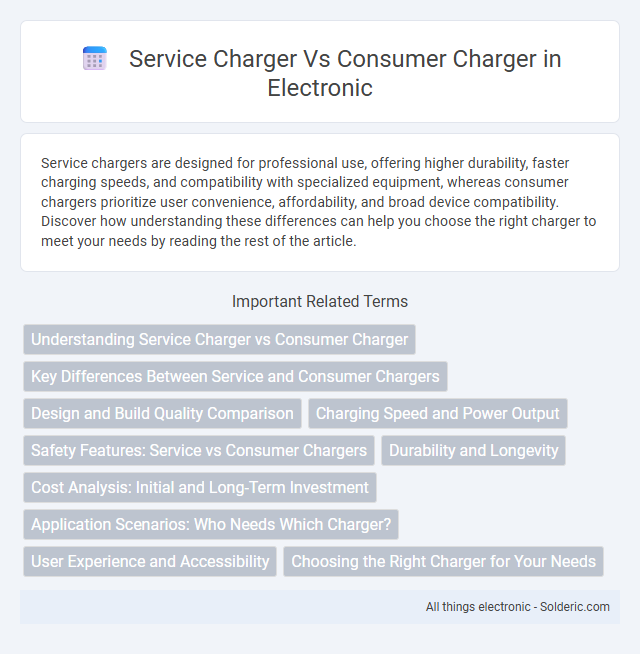Service chargers are designed for professional use, offering higher durability, faster charging speeds, and compatibility with specialized equipment, whereas consumer chargers prioritize user convenience, affordability, and broad device compatibility. Discover how understanding these differences can help you choose the right charger to meet your needs by reading the rest of the article.
Comparison Table
| Feature | Service Charger | Consumer Charger |
|---|---|---|
| Primary Use | Industrial and commercial charging | Personal and home device charging |
| Charging Speed | High-speed, fast charging capabilities | Standard speed, optimized for safety |
| Power Output | Higher wattage (typically 50W+) | Lower wattage (5-30W commonly) |
| Durability | Robust, built for heavy usage | Lightweight, for everyday use |
| Compatibility | Supports multiple devices and charging protocols | Device-specific or universal for consumer electronics |
| Portability | Less portable, often stationary | Highly portable, compact design |
| Price | Higher cost due to capacity and build | Affordable and accessible for consumers |
Understanding Service Charger vs Consumer Charger
Service chargers are designed for industrial or commercial applications, delivering higher charging capacity and faster energy transfer to power tools, machinery, or electric vehicles in professional settings. Consumer chargers focus on everyday use, offering compatibility and safety features tailored for personal electronics such as smartphones, laptops, and household gadgets. Understanding the distinctions in power output, durability, and intended usage helps users select the appropriate charger for optimized performance and device longevity.
Key Differences Between Service and Consumer Chargers
Service chargers are designed for industrial or commercial use, featuring robust build quality, higher voltage capacities, and enhanced safety mechanisms to handle continuous and heavy-duty charging demands. Consumer chargers prioritize portability, user-friendly interfaces, and compatibility with a wide range of personal electronic devices, often incorporating smart features like auto shut-off and energy efficiency. Understanding these key differences helps you choose the right charger that matches your specific power needs and device requirements.
Design and Build Quality Comparison
Service chargers typically feature robust metal housings, ruggedized components, and reinforced cables designed for durability in industrial or commercial environments, ensuring long-term reliability and resistance to wear and tear. Consumer chargers prioritize compactness, lightweight plastic materials, and sleek aesthetics to enhance portability and user-friendly operation, often compromising on ruggedness. The build quality of service chargers supports frequent heavy usage and environmental challenges, while consumer chargers focus on convenience and cost-effectiveness.
Charging Speed and Power Output
Service chargers typically offer higher power output and faster charging speeds compared to consumer chargers, making them ideal for industrial or commercial use where rapid turnaround is essential. Consumer chargers are designed for everyday personal devices with moderate power delivery to ensure safety and compatibility. When choosing your charger, consider the balance between charging speed and device requirements to optimize performance and avoid damage.
Safety Features: Service vs Consumer Chargers
Service chargers typically incorporate advanced safety features such as overcurrent protection, temperature monitoring, and automatic shutoff to handle higher power demands and extended use safely. Consumer chargers often include basic protections like short-circuit prevention and surge protection, prioritizing user convenience and everyday device compatibility. The enhanced safety mechanisms in service chargers reduce the risk of electrical faults and overheating during intensive operational conditions, distinguishing them from standard consumer models.
Durability and Longevity
Service chargers are engineered with high-quality components and robust construction, ensuring superior durability and extended longevity in demanding environments. Consumer chargers typically prioritize cost-effectiveness and portability but may lack the durability needed for heavy or continuous use, leading to shorter lifespans. Choosing a service charger enhances your investment by providing reliable performance and reducing the need for frequent replacements.
Cost Analysis: Initial and Long-Term Investment
Service chargers generally require a higher initial investment due to advanced technology and durability designed for frequent use, whereas consumer chargers are more affordable upfront but may lack longevity. Long-term costs of service chargers tend to be lower because of energy efficiency, reduced maintenance, and extended lifespan compared to consumer chargers, which may incur replacement and repair expenses over time. Evaluating total cost of ownership highlights service chargers as economically beneficial for heavy usage scenarios despite their steeper initial price.
Application Scenarios: Who Needs Which Charger?
Service chargers are tailored for industrial and commercial applications requiring rapid, high-capacity charging for electric vehicles or equipment, making them essential in fleet operations, service centers, and public charging stations. Consumer chargers suit individual users with low to moderate power needs, typically installed at home or workplaces for personal electric vehicle charging. Your choice depends on usage intensity and charging speed requirements, with service chargers addressing heavy-duty demands and consumer chargers providing convenient, everyday charging solutions.
User Experience and Accessibility
Service chargers typically offer faster charging speeds and are designed for public or commercial use, providing greater accessibility through widespread availability and compatibility with multiple device types. Consumer chargers prioritize user convenience with compact designs and plug-and-play functionality, enhancing the overall user experience for personal, everyday use. The balance between accessibility and usability in service versus consumer chargers significantly affects how efficiently users can charge devices in different environments.
Choosing the Right Charger for Your Needs
Service chargers offer higher power output and durability designed for professional or heavy-duty use, ensuring fast and reliable charging for commercial equipment. Consumer chargers prioritize convenience and compatibility with everyday devices, featuring lower power ratings suitable for smartphones, tablets, and laptops. Selecting the right charger depends on device power requirements, charging speed needs, and usage environment for optimal performance and safety.
Service charger vs Consumer charger Infographic

 solderic.com
solderic.com